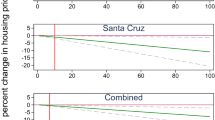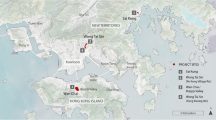Abstract
Florida’s Gulf Coast is known as a retirement hotspot, with property values along the coast rising faster than almost anywhere else in the country. However, the coastal amenities that help boost prices, quickly turn to dis-amenities when there is a prolonged red tide bloom in the Gulf. Using a difference in differences hedonic valuation model, we examine six Southwestern Florida counties heavily impacted by four major algal bloom in the past 20 years. We find that affected properties within 1 mile of the coast sell for up to 30% less compared to similar homes sold during the same month in an unaffected county. With red tide predicted to increase in frequency and severity, mitigation of the effects must be paramount for these counties. Losses occur in almost all sectors of the economy, and for a state that relies so much on the health of the environment, declines in property values are a sign that action must be taken against these blooms.

Similar content being viewed by others
References
Bejranonda, S., Hitzhusen, F. J., Hite, D., Uri, N. D., & Lewis, J. A. (1999). Agricultural sedimentation impacts on lakeside property values. Journal of Agricultural and Resource. Economics, 28(2), 208–218.
Bin, O., & Czajkowski, J. (2013). The impact of technical and non-technical measures of water quality on coastal waterfront property values in South Florida. Marine Resource Economics, 28(1), 43–63.
Boyle, K. J., Poor, P. J., & Taylor, L. O. (1999). Estimating the demand for protecting freshwater lakes from eutrophication. American Journal of Agricultural Economics, 81(5), 1118–1122.
Calderón-Arrieta, D., Caudill, S. B., & Mixon, F. G. (2019). Valuing recreational water clarity and quality: Evidence from hedonic pricing models of lakeshore properties. Applied Economics Letters, 26(3), 237–244.
Fleming, L. E., Kirkpatrick, B., et al. (2005). Initial evaluation of the effects of aerosolized Florida red tide toxins (brevetoxins) in persons with asthma. Environ Health Perspective, 113(5), 650–657.
Flewelling, L. J., Naar, J. P., et al. (2005). Brevetoxicosis: Red tides and marine mammal mortalities. Nature, 43, 755–756.
Florida Fish and Wildlife Conservation Commission. (2018). Internet Site: https://myfwc.com/research/redtide/statewide (Accessed July 2019).
Gibbs, J. P., Halstead, J. M., Boyle, K. J., & Ju-Chin, H. (2002). A hedonic analysis of the effects of lake water clarity on New Hampshire lakefront properties. Journal of Agricultural and Resource. Economics, 31(1), 39–46.
Hindsley, P., Hamilton, S., & Morgan, O. (2013). Gulf views: Toward a better understanding of Viewshed scope in hedonic property models. The Journal of Real Estate Finance and Economics, 47(3), 489–505.
Landry, C., & Hindsley, P. (2011). Valuing Beach quality with hedonic property models. Land Economics, 87(1), 92–108.
Larkin, S. L., & Adams, C. M. (2007). Red tides and coastal businesses: measuring economic consequences in Florida. Society and Natural Resources, 20.
Legget, C., & Bockstael, N. (2000). Evidence of the effects of water quality on residential land prices. Journal of Environmental Economics and Management, 39(2), 121–144.
Liu, T., Opaluch, J. J., & Uchida, E. (2017). The impact of water quality in Narragansett Bay on housing prices. Water Resource Research., 53(8), 6454–6471.
Morgan, K., Larkin, S., & Adams, C. (2009). Firm-level economic effects of HABS: A tool for business loss assessment. Harmful Algae, 8, 212–218.
Nicholls, S., & Crompton, J. (2018). A comprehensive review of the evidence of the impact of surface water quality on property values. Sustainability (Switzerland), 10(2), 500–530.
NOAA. (2018). Harmful algal blooms observing system. Internet Site: https://service.ncddc.noaa.gov/website/AGSViewers/HABSOS/maps.htm (Accessed June 2019).
Papenfus, M. (2019). Do housing prices reflect water quality impairments? Evidence from the Puget Sound. Water Resources and Economics., 27, 100–133.
Pierce, R. H., & Henry, M. S. (2008). Harmful algal toxins of the Florida red tide (Karenia brevis): Natural chemical stressors in South Florida coastal ecosystems. Ecotoxicology (London, England), 17(7), 623–631.
Pierce, R. H., Henry, M. S., Dickey, R., & Plakas, S. (2002). NSP toxins and metabolites in oysters, clams, and whelks. Harmful algae.
Pierce, R. H., Henry, M. S., Blum, P. C., Hamel, S. L., Kirkpatrick, B., Cheng, Y. S., et al. (2005). Brevetoxin composition in water and marine aerosol along a Florida beach: Assessing potential human exposure to marine biotoxins. Harmful Algae, 4, 965–972.
Plakas, S. M., el-Said, K. R., et al. (2002). Confirmation of brevetoxin metabolism in the eastern oyster by controlled exposures to pure toxins and to Karenia brevis cultures. Toxicon., 40(6), 721–729.
Roberts, B. S. (1979). Occurrence of Gymnodinium breve red tides along the west and east coasts of Florida during 1976 and 1977. In D. L. Taylor & H. H. Seliger (Eds.), Toxic dinoflagellate blooms (pp. 199–202). New York: Elsevier North Holland, Inc..
Rosen, S. (1974). Hedonic prices and implicit markets: Product differentiation in pure competition. The Journal of Political Economy, 82(1), 34–55.
Sarasota Herald-Tribune. (2006). Red Tide Timeline. FL: Sarasota.
State of Florida. (2019). MyFlorida State Agencies. Internet site: http://www.myflorida.com/ (Accessed July 2019).
Tuttle, C. M., & Heintzleman, M. D. (2015). A loon on every lake: A hedonic analysis of lake water quality in the Adirondacks. Resource Energy Economics, 39, 1–15.
Van Dolah, F. M. (2000). Marine algal toxins: Origins, health effects, and their increased occurrence. Environ Health Perspective, 108, 133–114.
Walsh, P. J., Milon, J. W., & Scrogin, D. O. (2011). The spatial extent of water quality benefits in urban housing markets. Land Economics, 87(4), 628–644.
Wolf, A., & Klaiber, A. (2017). Bloom and bust: Toxic algae's impact on nearby property values. Ecological Economics, 135, 209–221.
Zillow. (2019). Florida home prices and values. Internet site: https://www.zillow.com/fl/home-values/ (Accessed July 2019).
Author information
Authors and Affiliations
Corresponding author
Additional information
Publisher’s Note
Springer Nature remains neutral with regard to jurisdictional claims in published maps and institutional affiliations.
Rights and permissions
About this article
Cite this article
Bechard, A. Gone with the Wind: Declines in Property Values as Harmful Algal Blooms Are Blown Towards the Shore. J Real Estate Finan Econ 62, 242–257 (2021). https://doi.org/10.1007/s11146-020-09749-6
Published:
Issue Date:
DOI: https://doi.org/10.1007/s11146-020-09749-6




